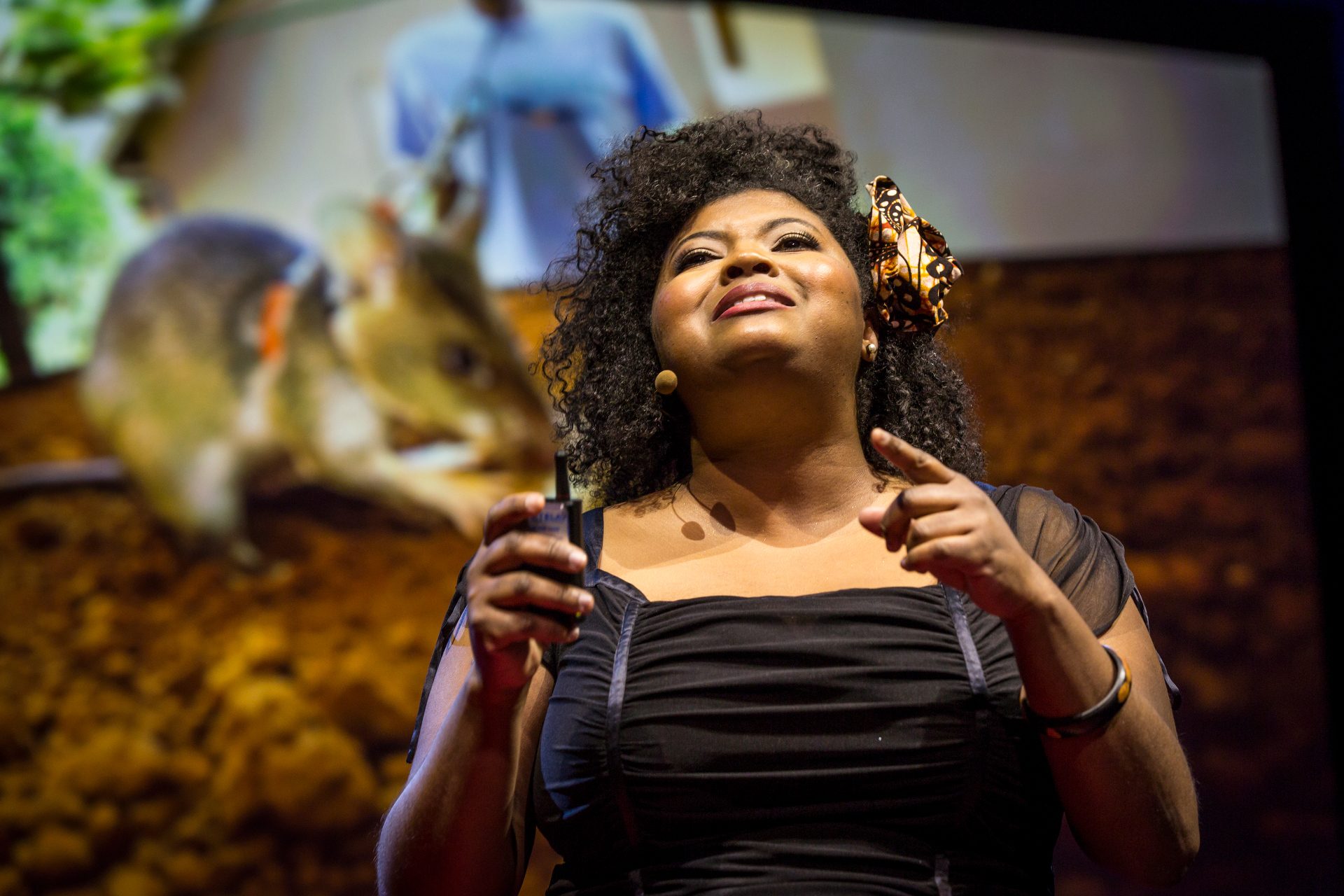
Evolutionary biologist Danielle N Lee researches the ecological and evolutionary behaviors of
African giant pouched rats. She speaks at TED Fellows Talks session 2, during TED2015. Photo: Ryan Lash/TED
In Session 2 of the TED Fellows talks, we learn about the FBI’s use of informants in counterterrorism operations, how giant pouched rats are helping to save lives, laser-delivered HIV drugs, how Silicon Valley companies are working to protect our privacy — and that’s not to mention the piano solo, percussive dance and opera!
Sri Lankan opera singer Tharanga Goonetilleke opens Session 2 with Magda’s aria from the opera La Rondine by Puccini, accompanied on piano by Tina Chang. “The character sings of true and passionate love that is better than all the riches of the world,” says Goonetilleke.
“The FBI is responsible for more terrorism plots in the United States than any other terrorist organization” begins investigative journalist Trevor Aaronson. After 9/11, the FBI were instructed to find terrorists before they strike — and this pursuit of terror has consumed the agency to the tune of $3.3 billion a year. While there have been only a handful of successful domestic terror attacks, the FBI boasts that it’s foiled dozens of terrorism plots in their undercover sting operations, and have arrested more than 175 people in counterterrorism stings. According to Aaronson, many of these are orchestrated by the FBI itself, who pay informants $100,000 or more to seek out and “inform” on often-impoverished and mentally ill Muslim-Americans. The FBI then provide the suspects with all they need to execute a terrorist plot — weapons, a martyrdom video, and money — which are then stopped, just in time, by the FBI. Until now, Aaronson has drawn his startling conclusions from years of poring over domestic terrorism prosecution files. But in an article published this morning in Intercept, Aaronson has revealed the transcript of a secret recording of FBI agents, proving they knew would-be terror suspect Sami Osmakac — who has schizoaffective disorder and was lured by an undercover FBI agent into plotting a bombing — was incapable of the crime. Osmakac was subsequently arrested, convicted, and sentenced to 40 years in prison, an unwitting victim of what Aaronson calls the theater of national security.
Meet David Lang’s hero John Dobson, the amateur astronomer who created the Dobsonian telescope and was a pioneer in the realm of amateur science who spent his life teaching people the joy of constructing their own telescopes. It’s been hard for other scientific disciplines to replicate amateur activity, says Lang. But now, low-cost, accessible tools like cheap sensors, the rise of open standards, and the ability for fellow enthusiasts to connect over the internet is creating what he calls the era of Connected Exploration. As the tools for science, conservation and innovation have gotten more accessible and powerful, communities in Borneo are using drones to monitor their forests; in Japan, makers and hackers built Geiger counters to monitor the impact of Fukushima in real time; DIY biologists are competing with each other to design engineered microbes. In this context, science and discovery is not about efficiency and convenience, but wonder and adventure. One thing is clear, says Lang, ”When you give people the tools to ask questions, they will surprise you with what they ask and what they discover.”
Choreographer Camille A. Brown performs a passionate and percussive solo dance excerpted from BLACK GIRL: Linguistic Play, accompanied on piano by Scott Patterson. “This dance reveals the complexity of carving out a self-defined identity as a black female in urban American culture,” says Brown.
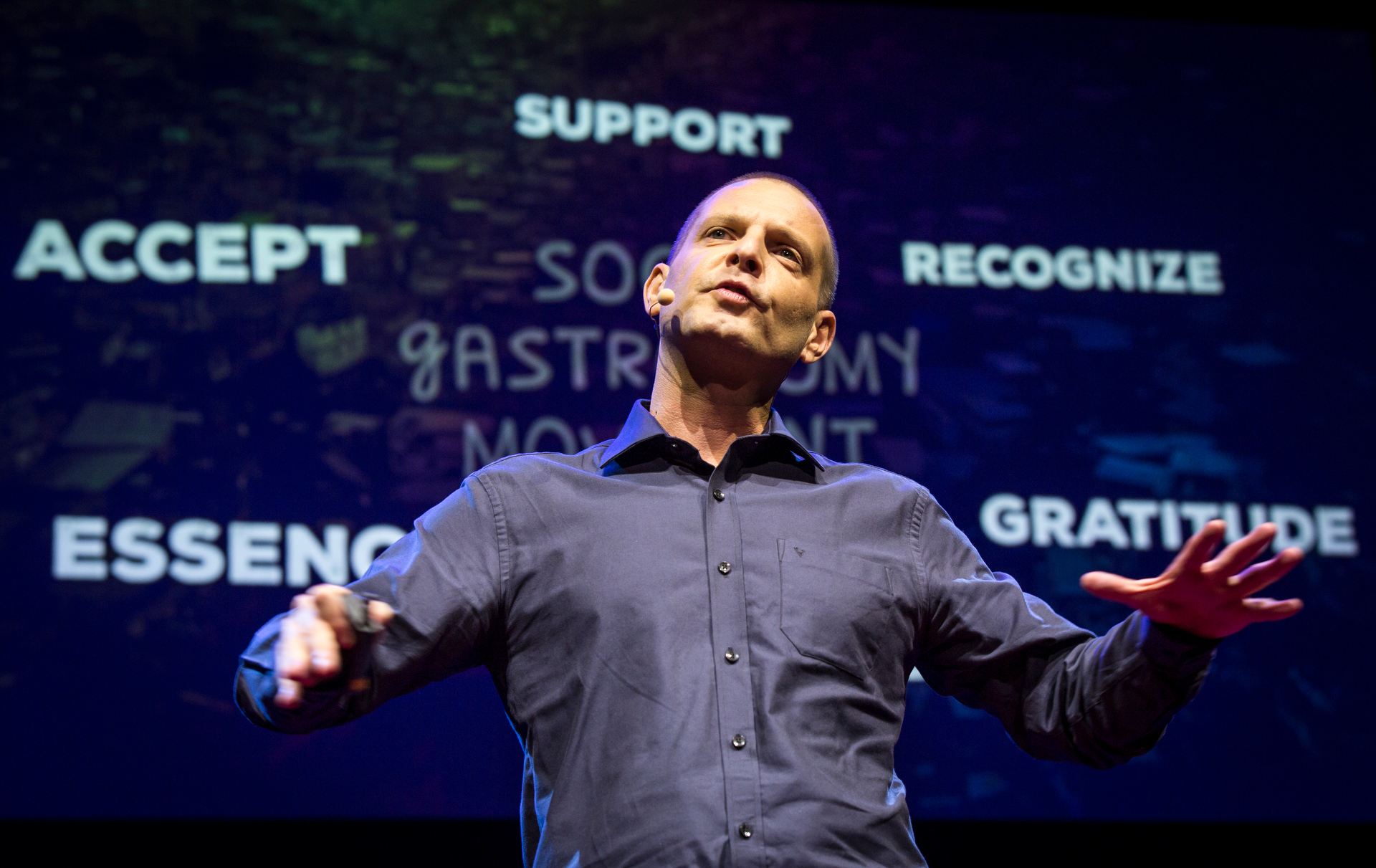
Chef (and TED Fellow) David Hertz speaks on the power of food to transform millions of lives. Photo: Ryan Lash/TED
For David Hertz, becoming a chef in his native Brazil was a very personal journey searching for meaning, purpose and confidence. As a youth, he had traveled the world, seeking his own true potential. Along the way, he picked up a passion for food. “Gastronomy became the guideline of my life,” he says. He enrolled in Brazil’s first culinary academy, but even as a successful chef, he wondered whether he could do more? An invitation to visit a social project in a favela — a place steeped in poverty, violence and drug trafficking — made him think. If food could offer a path to empowerment for Hertz, maybe it could for these people living on the fringes of society, too. He created an organization, Gastromotiva, to promote a movement called Social Gastronomy, offering free culinary training for favela residents, who then go on to work in well-paid jobs, as well as offering workshops to favela communities on how to cook and use healthy ingredients. Over seven years, the organization has trained more than 1,200 kitchen assistants and taught more than 30,000 favela residents. Hertz is now moving beyond favelas to work with other socially excluded communities, such as unemployed immigrants and prison inmates — using food to transform lives and build bridges between social groups.
Tharanga Goonetilleke returns to the stage to tell her extraordinary story, from a childhood marred by the Sri Lankan civil war to become Sri Lanka’s only professionally trained opera singer. Music was her haven — and as she listened to recordings of Kiri Te Kanawa as a child, she’d imagine her own voice soaring above the orchestra. A chance meeting with an American musician who heard her sing miraculously paved the way for her to study music in the United States. Her first day at university was September 11, 2001. As her classmates reacted to the tragedy with fear and grief, Goonetilleke realized she felt almost nothing. Having lived with war all her life, she’d been numbed by constant exposure to violence. This realization “marked the beginning of the healing of a hardened soul,” she says. The first role Goonetilleke performed was Pamina in The Magic Flute. In a story that deals with themes of darkness and light, corruption and innocence, good and evil, she sang her suppressed emotions into the music, and learned that it’s ok to cry. “Music truly unlocked me,” she says. “Words often fail to express what I have to say, and that’s why I sing.”
The unlikely and unsung hero who is out there fighting a scourge of landmines is — a rodent. An African giant pouched rat, to be exact. Behavioral biologist Danielle N Lee studies these creatures, which were first deployed in Mozambique in 2000 by APOPO — a Belgian humanitarian organization — to detect and clear landmines. These kill or maim up to 20,000 people each year in formerly war-torn countries in Africa and Asia, and deprive people of valuable agricultural land. The rats are easy to train and care for, adaptable and too light to detonate the mines. Trained to detect TNT, the rats walk systematically up and down a field, and scratch at the ground to signal a find, while trainers note the location. Yet not much is known about these animals. Lee’s research gathers information about their social structure, their reproductive cycles, how they respond to various environments and so on. She also assesses individual rats to determine which are best for various jobs — not just mine clearing, but inspecting baggage and cargo containers — and compares their behavior to genetic data. Her research will help selectively breed rats for efficiency, and deploy them as soon as possible to save more lives.
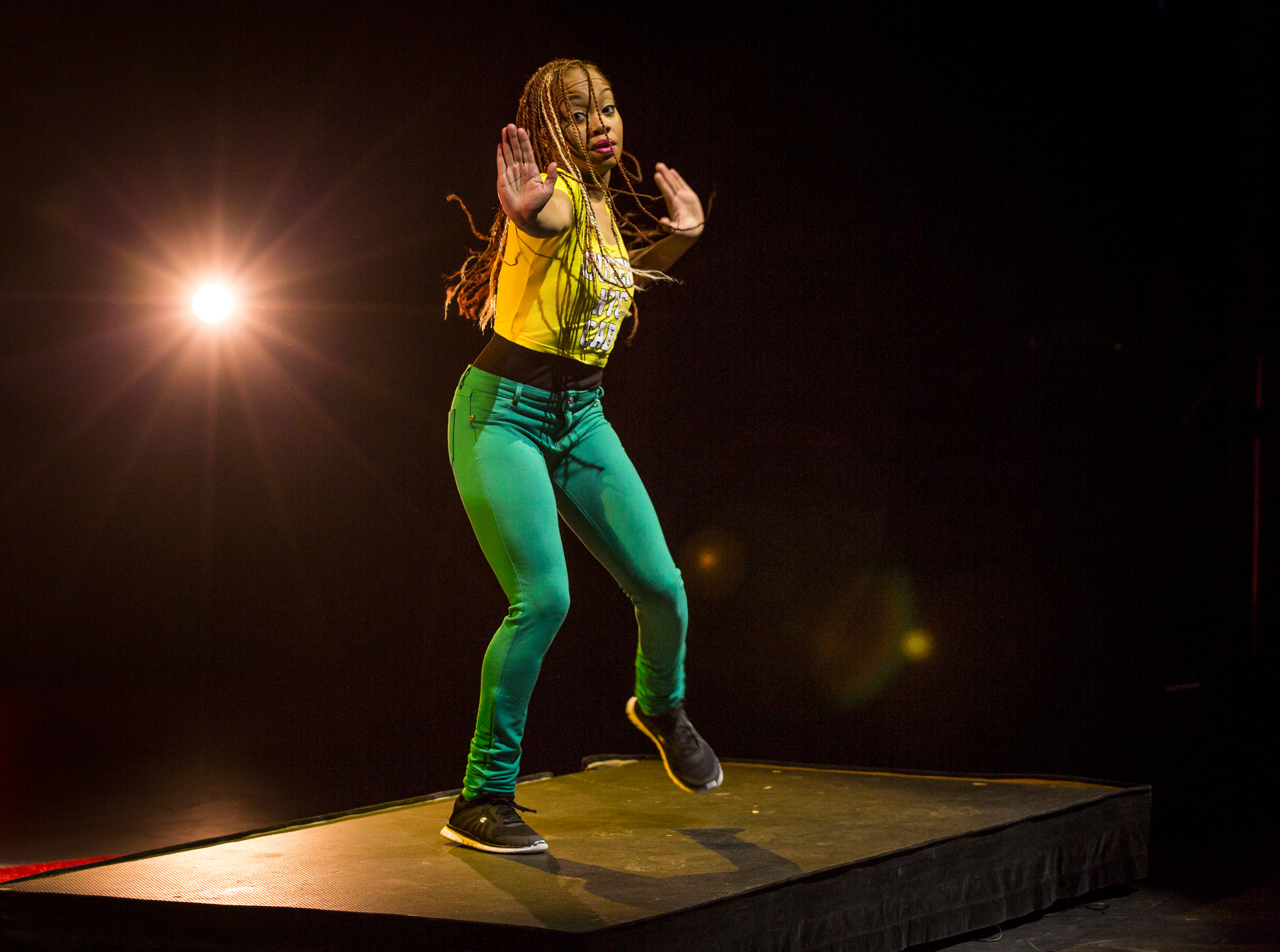
Camille Brown performs during Fellows session 2, TED2015 – Truth and Dare, March 16-20, 2015, Kay Meek Center, West Vancouver, Canada. Photo: Ryan Lash/TED
When she was a little girl, dancer and arts activist Camille A. Brown’s passion was for LEGO. Nothing made her happier than going to her grandparents’ house, switching on her favorite cartoon, and diving into her building blocks — after doing a dance specially choreographed to the theme song of the Gummi Bears, of course! When she grew up, she was told at dance school her body wasn’t quite right for dance — but she persevered, and found her joy in dance composition, another form of building. Her work now powerfully interrogates and reclaims the narratives of what it means to be black in America — particularly a black girl — refusing to allow anyone to dictate what stories she could tell and how she tells them. Despite some pushback, Brown has built her own unique system and structure as a choreographer, dancer and community builder, using the language of dance to carve out a self-defined identity as an African American female and as a platform for dialogue about race.
Laser scientist Patience Mthunzi is creating a way to use lasers to deliver HIV drugs directly to infected cells. Taking medicines orally is the easiest, most painless way to deliver drugs to the human body, but the medicine is diluted as it travels through our systems on the way to the affected area, reducing effectiveness. This is also true of anti-HIV drugs, which are diluted before they reach certain HIV viral reservoir sites like the lymph nodes, nervous system and white blood cells. When patients stop receiving consistent HIV treatment, the virus can reawaken to infect new cells. Mthunzi is developing a method that uses lasers to pierce tiny holes in HIV-infected cells to deliver medicine directly. She is now carrying out the research in petri dishes, but the goal is to test it in the human body using a three-headed device that will include a laser, a camera to find the site of infection and a drug delivery mechanism. If it works, this technology could one day totally eradicate HIV in the system – a cure led by lasers.
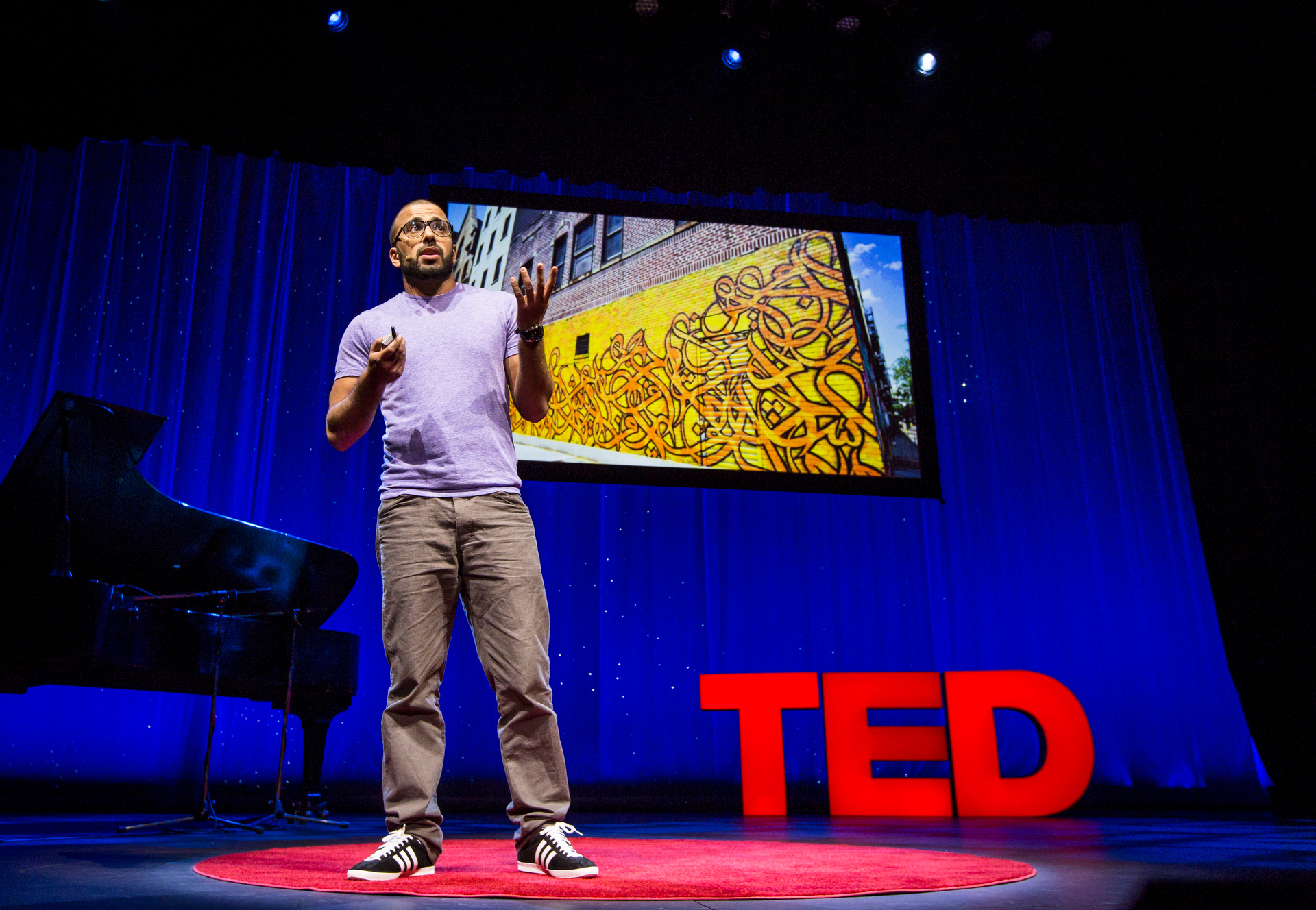
eL Seed speaks about his Arabic calligraphic graffiti art during TED Fellows Talks, session 2, during TED2015. Photo: Ryan Lash/TED
Are walls an instrument of separation, or an invitation to engage in culture, language and art? Tunisian-French artist eL Seed paints calligrafitti – gorgeously painted Arabic script, most often fragments of poetry or quotes – that decorate public places, from a mosque’s minaret in Tunisia to the rooftops of Rio’s favelas to a wall in a Cape Town slum and beyond. eL Seed picks messages that are not only relevant to the location, but that a global audience can relate to. On a minaret in his hometown of Gabes, Tunisia, for example, the script quotes the Qur’an in a universal message of peace: “O humankind, we have created you from a male and a female and made you people and tribes, so you may know each other.” On the wall of a school in Cape Town, Nelson Mandela: “This is impossible until it’s done.” Raised in France, eL Seed learned to read and write in Arabic when he was 18, but, he says, it doesn’t matter if people can’t decipher his script, believing it doesn’t require translation: the beauty of the script reaches the soul before its meaning.
Coral scientist Kristen Marhaver investigates what baby corals need to thrive. To do this, she scuba dives at night to catch coral spawn when they are released into the water – an event that happens only once a year — and raising the larvae in the lab. In experiments, Marhaver and her colleagues have discovered that corals not only have surface texture and color preferences, they’re also drawn to certain bacterial scents. This data allows researchers to construct inviting environments that encourage and boost coral settlement back in the ocean using reintroduced lab-raised juvenile coral. Today, Marhaver is making an important announcement: her research team recently able to harvest the spawn of and successfully breed the Caribbean pillar coral. Until now, scientists had not been able to find a juvenile pillar coral on the reef, leading them to suspect the species had stopped reproducing. Now Marhaver proudly shows the TED Fellows audience the first photograph of a baby pillar coral the world has ever seen. This means that not only can the species still reproduce, but we now have the research tools to study why they are disappearing and how to boost their population. We may be able to shift the odds in favor of restoring the world’s corals after all. (For more, visit “A day in the life of a baby coral,” a piece by Marhaver on the TED Ideas blog.)
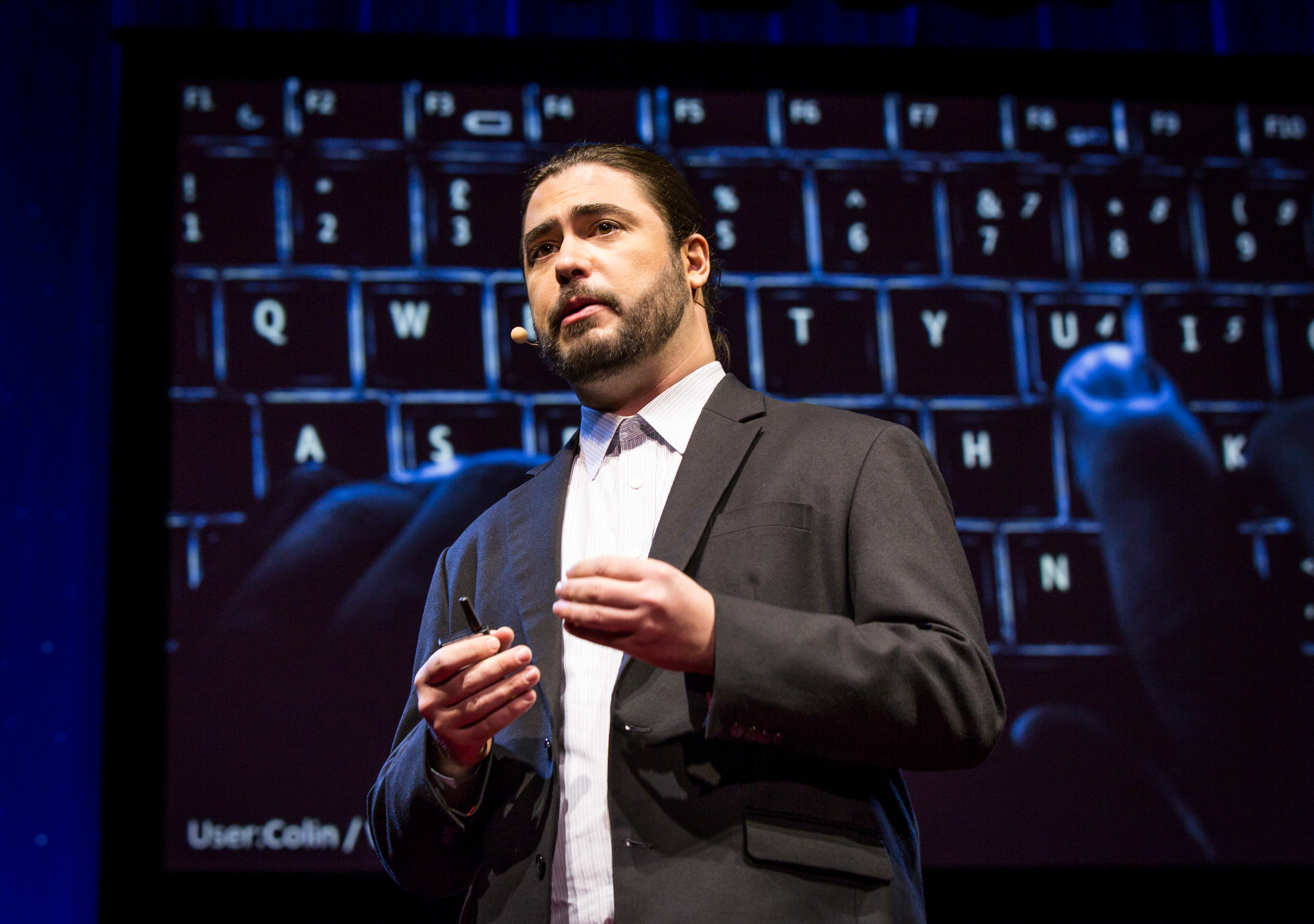
Christopher Soghoian on ways government surveillance makes us all less secure. Photo: Ryan Lash/TED
Whether you know it or not, you are likely using communications technology that’s much more secure than the telephone and tech services we used to use, says privacy researcher Christopher Soghoian. For more than a century, phone companies have prioritized surveillance, building it into the core of their networks. This means when you’re talking on your phone, anyone could be listening — your own government, a foreign state, a hacker, a stalker. However, some Silicon Valley companies are taking the opposite approach, building strong encryption into their communication apps. Texts sent between iPhones are encrypted, for example, as is Apple’s Facetime app. Whatsapp, owned by Facebook, also features strong encryption technology. Government officials aren’t happy Silicon Valley companies have democratized encryption. But, says Soghoian, for governments to monitor drug dealers and terrorists, they have to be able to monitor everyone. Do we really want to live in a world where anyone can hack our private communication? Soghoian doesn’t think so, and encourages us to use the private communication tools we now have at our disposal — not just because they’re cheap and easy, but because they’re secure. Read Soghoian’s smart advice on keeping your data safe.
With powerful words and images, artist and photographer LaToya Ruby Frazier speaks of her home town of Braddock, Pennsylvania, an industrial suburb where the steel industry once thrived. Over the past 12 years, Frazier has produced still lifes, portraits, landscapes and aerial views to document the impact of the steel industry on her family and community. The current mainstream narrative paints Braddock as a place of thriving Rust Belt regeneration — a gentrified destination for “urban pioneers” — but for Frazier’s family, the narrative goes back generations. From her grandmother’s time to her own coming-of-age, Frazier’s family watched as a prosperous industrial town fell prey to white flight when the steel mills closed, resulting in economic abandonment and government divestment that’s taken a heavy toll on the community left behind. Frazier’s images of urban decay are both beautiful and disturbing to look at, but the visual history it presents is an important testament to the history of racism and inequality in industrial America.
Pakistani musician, composer, filmmaker and artist Usman Riaz closes out the TED2015 Fellows talks with his original piece, “Creation of the Universe,” performed solo on piano. (See the multitalented Riaz performing an amazing percussive guitar duet with Preston Reed at TEDGlobal 2012.)
Comments (1)